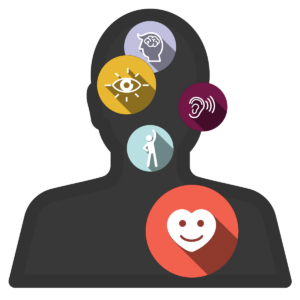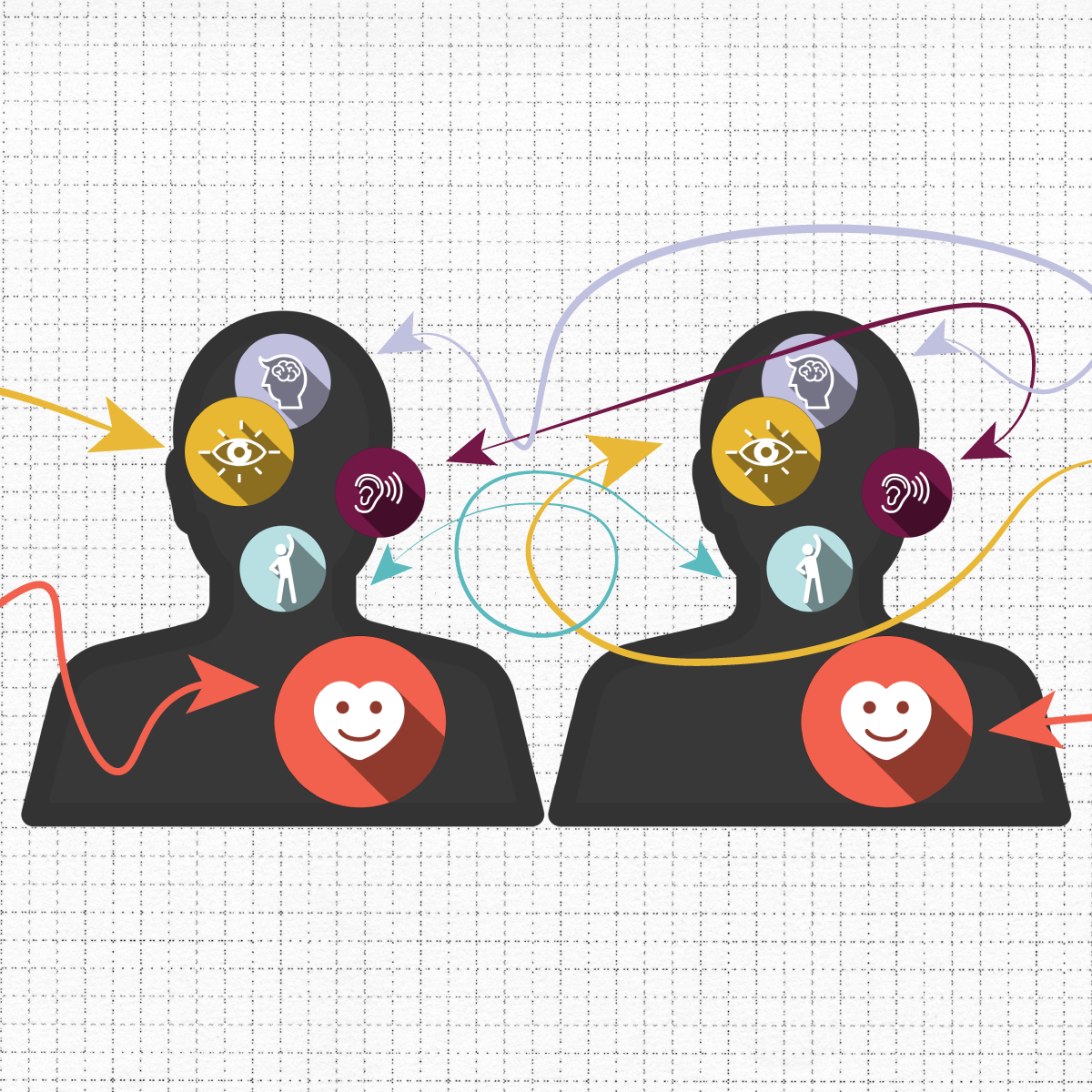The ability to understand yourself and others is one of the best possible outcomes of an education. Recognizing that any issue or action can be seen from many perspectives and that these perspectives are the result of each individual’s experiences and thoughts is a key step toward building strong, compassionate communities. Research tells us that SEL programs can improve academic outcomes, reduce emotional distress, and promote pro-social behavior (Zinsser et al., 2016).
Two strategies often used in SEL programs are empathy mapping and role-playing. These activities allow students to step into the shoes of others—whether classmates, community members, individuals from different generations or cultural backgrounds, or even fictional characters—providing opportunities to recognize and appreciate different perspectives and develop empathy.
What Are Empathy Mapping and Role-Playing?
 Empathy Mapping:
Empathy Mapping:
An empathy map is a visual tool that uses observations to help students explore the thoughts, feelings, and motivations of others by asking questions such as:
- What might this person think or feel?
- What are their concerns or fears?
- What do they see and hear in their environment?
This process encourages learners to develop a nuanced understanding of others’ lived experiences. A study by Decety and Jackson (2004) found that empathy-related activities strengthen the neural circuits involved in perspective-taking and emotional regulation.
The empathy map is usually divided into quadrants that prompt students to consider multiple dimensions of an individual’s perspective. The quadrants often track what the person said, did, thought, and felt, but can also add other experiences by combining some to track what they thought and felt, saw, heard, and said and did as they do in our Empathy Map Template (PDF).
Role-Playing:
Role-playing encourages critical thinking about social justice issues, as students are often tasked with addressing dilemmas involving fairness, equity, or exclusion (Kumashiro, 2004). During role-playing, students take on the roles of different individuals, acting out scenarios based on real-life situations. This active approach to learning immerses students in another person’s worldview and encourages them to problem-solve or empathize with the person or character they are portraying. The skills they develop help students navigate complex, real-life social situations or conflicts.
Why Are These Strategies Valuable for Students?
Both empathy mapping and role-playing build skills that are essential for personal development and social cohesion and help students:
- Understand Multiple Perspectives: By stepping into someone else’s shoes, students can better appreciate how others see the world as the develop cognitive empathy.
- Develop Social and Emotional Intelligence (SEL): According to research by Goleman (2006), social and emotional intelligence involves recognizing emotions in oneself and others and using this awareness to guide behavior. These strategies promote self-awareness, emotional regulation, and interpersonal skills.
- Enhance Problem-Solving and Collaboration: Understanding diverse perspectives enables students to work more effectively in groups, a critical skill for both academic success and future workplace environments.
- Promote Equity and Inclusion: By fostering an understanding of diverse experiences, these strategies equip students to challenge biases, stereotypes, and systemic inequities.
Try it With Your Students!
 Elementary School: Role-Playing Conflict Resolution
Elementary School: Role-Playing Conflict Resolution
Teach conflict resolution by exploring different perspectives.
Step 1: Present a simple, relatable scenario.
Set the stage; “Okay everyone, let’s imagine two children are arguing over a toy during indoor recess. Think to yourself about what might be happening.” (Allow time for the class to think about the situation.)
Step 2: Assign students to different roles.
You might say something like, “Beto has volunteered to play the child who wants the toy and Genevieve is going to take on the role of the child who was already playing with the toy. Let’s chat for a minute about what we predict each of these children might be thinking and feeling. How might we see or hear these thoughts and feelings?” (Provide time for students to share ideas and for the actors to think a bit about their roles.)
Step 3: Ask the students to act out how each child feels, thinks, and reacts in the situation. Provide guardrails as needed to ensure feelings don’t get out of hand as the children work through the situation.
Step 4: Facilitate a discussion in which students recall what happened and identify the perspective of each of the children who were portrayed. Guide students in reflecting on how each character might resolve the conflict fairly and use questions and prompts to ensure students are taking on the perspective of both characters.
Activities like this provide safe opportunities for students to practice listening, empathy, and compromise. Taking time to understand and acknowledge how others think and feel develops emotional intelligence and prepares learners for more effective conflict resolution.
 Middle School: Empathy Mapping for Social Studies
Middle School: Empathy Mapping for Social Studies
Use empathy mapping to understand historical figures or social issues.
Step 1: Select a social issue or historical event. (e.g., the Civil Rights Movement).
Build context by sharing ideas such as, “Every time and place has its own issues. When we look back into the past from a time before we were born, history often seems like a story and it’s important we remember these “characters” from history had the basic needs, feelings, hopes and dreams that we do today. Looking back the “right” perspective or solution may be obvious, but that doesn’t mean it was at the time.”
Step 2: Assign different roles (e.g., civil rights activists, government officials, bystanders).
Get students started by saying something similar to, “It’s time to decide which characters you will play. Remember that some of these roles may feel uncomfortable. Once you decide, look over the descriptions for civil rights activists, government officials, and bystanders.”
Step 3: Have students fill out an empathy map for their character, considering what they might think, feel, see, and do during that time.
Step 4: Engage in a class discussion where students share insights from their maps and discuss how understanding different perspectives helps create a fuller picture of history. Be prepared to facilitate when students are discussing difficult topics and to act as a moderator or facts checker when students share information that may be from an untrustworthy source.
Engaging in these discussions, and the preparation leading up to them, enables students to gain deeper insights into historical contexts and develop the ability to think critically about social issues now and in the past.
 High School: Role-Playing for Ethical Dilemmas
High School: Role-Playing for Ethical Dilemmas
Use empathy mapping and role playing to explore complex ethical questions.
Step 1: Present a moral dilemma relevant to the students. It might be something inside the school such as sharing photos or videos of others without their explicit permission or an issue from the larger community like companies using data from social media for targeted advertising. It is important that these issues do not have a clear “right” answer.
Launch with a question. “What are the benefits and drawbacks of companies using your personal information and habits to match specific ads to you?” These questions can be followed with others, “Should this be legal? Should there be restrictions or options?”
Step 2: Divide learners into groups representing different roles such as students, teachers, guardians, and administration or consumers, company executives, and privacy advocates depending on the situation.
Prompt the students to explore the perspective of the people in their role using an empathy map. “It’s time to decide which characters you will play. Remember that some of these roles may feel uncomfortable. Once you have your role, research how people in this position are related to the issue and what position(s) they are likely to take. Use your empathy map to summarize what they would see, hear, think and feel, and say and do. This understanding will support your ability to debate from their perspective. Especially if you have a differing perspective.”
Step 3: Allow students time to research the position(s) of people in the role they will be assuming.
Prompt the students to explore the perspective of the people in their role using an empathy map. “Now that you have your role, research how people in this position are related to the issue and what position(s) they are likely to take. Use your empathy map to summarize what they would see, hear, think and feel, and say and do. This understanding will support your ability to debate from their perspective. Especially if you have a differing perspective.”
Step 4: Have students role-play a debate in which they adopt and defend their viewpoint of their character. Make time to either review or co-construct shared agreements for this specific type of discussion/debate with an emphasis on differentiating between the person and the role they are taking on.
Step 5: Facilitate a reflective conversation about how each perspective contributes to the ethical complexity of the issue.
Spending time with the complexity of issues like these, that students will face throughout their lives, enables students to appreciate differing and even opposing viewpoints. Practicing researching and debating, especially in this relatively low risk setting, develops critical thinking and moral reasoning skills.
Empathy mapping and role-playing are powerful strategies for fostering equity, inclusion, and social-emotional intelligence. When a person can take on the perspectives of others, they gain empathy and can learn to use this superpower in complex and challenging situations throughout their lives.
Ready to Create Your Own Examples?
Adapt the step-by-step directions below to your own situation. You may not need every step to accomplish your goals, but they will help you think through the process.
- Select a Scenario or Topic: Choose an issue, character, or historical figure that aligns with your curriculum goals.
- Define Roles or Perspectives: Identify the key perspectives or roles that need to be explored.
- Create or Introduce the Empathy Map: If using empathy mapping, provide students with the visual tool and guide them through each quadrant. With repetition, students will be able to complete these without teacher support.
- Assign Roles or Positions: In the case of role-playing, assign students their roles or let them choose based on interest. With practice, students will be able to facilitate these skits and multiple smaller groups can be engaged at a time.
- Facilitate Active Exploration: Encourage students to either act out their roles, fill in their empathy maps with detailed responses, or both.
- Debrief and Reflect: Close with a reflective discussion. Ask students what they learned about the character or issue and how their understanding has shifted. Challenge them to discuss the experience from perspectives other than their own.
- Extend the Learning: Incorporate follow-up activities such as journal writing, group discussions, or creative projects to deepen understanding.Empathy mapping and role-playing are not just tools for academic success; they are essential strategies for fostering equity, inclusion, and social-emotional intelligence. When a person can take on the perspectives of others, they gain empathy and can learn to use this superpower in complex and challenging situations throughout their lives.



